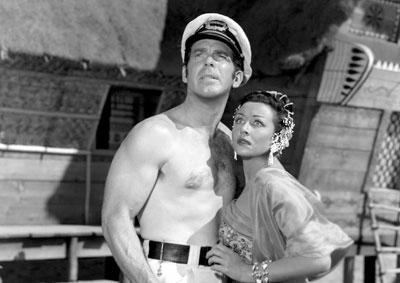Directed by Joseph Kane
What would a Hollywood South Seas adventure be without the cultural-historical gaffes, racial stereotyping and plot improbabilities to spice up the recipe of romancing and action in an exotic locale? This postwar Republic Pictures production—directed with B-movie proficiency by the studio's mainstay and western specialist Joseph Kane—delivers on all counts.
Fred MacMurray—ever the versatile leading man, here about midpoint between his cynical insurance adjuster of Double Indemnity (1944) and the TV paterfamilias of My Three Sons (1960-1972)—plays Captain Boll, an up-by-the-bootstraps American commanding the scrappy crew of the sailing ship, Gerrymander. The year is 1883, and Boll is plying the waters off the island of Java, trying to steer free of the law (the Dutch enforcing their colonial monopoly on trade) and pirate lawlessness. (Standing in for the Dutch East Indies [present-day Indonesia] is Hila, Hawaii and Point Dume in Malibu.)
While in pursuit of a hidden trove of diamonds, Boll rescues Kim Kim (Vera Ralston), a Eurasian beauty with a secret all the movie's men are after. The wife of Republic studio chief Herbert J Yates and an ice-skater in her native Czechoslovakia, Ralston slinks through Fair Wind in sarong-clad glamour, and—as Martin Scorsese, a fan of the movie, has reportedly noted—"did everything in the same accent. Czechoslovakian."
There's plenty of manly brawling, briskly paced, from an attempted mutiny and pirate attacks to an escape from an island prison. A pretend Javanese dance sequence and Ralston's frequent costume changes provide the sole feminine diversions. Then in the climactic special effects spectacular, Krakatua erupts, unleashing a tsunami. All this matinee fun and more is now restored in Trucolor.
–Cheng-Sim Lim
Republic Pictures Corp. Producer: Herbert J Yates Screenwriter: Robert Tregaskis Based on the novel "Fair Wind to Java" by Garland Roark Cinematographer: Jack Marta Art Directors: Frank Arrigo. Frank Hotaling (uncredited). Asoka (uncredited) Editor: Richard L. Van Enger Music: Victor Young Special Effects: Howard Lydecker. Theodore Lydecker Cast: Fred MacMurray, Vera Ralston. Robert Douglas. John Russell. Victor McLaglen
35mm. color. 92 min.
Preserved in cooperation with Paramount Pictures from a 35mm acetate Eastman Color interpositive and from a set of 35mm acetate separation master positives. Laboratory services by YCM Laboratories. Special thanks to: Bany Allen.






 Mobile Navigation
Mobile Navigation

